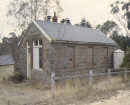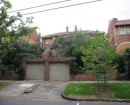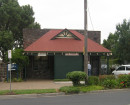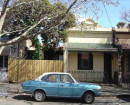290 & 300 Burnley Street
290 & 300 BURNLEY STREET RICHMOND, YARRA CITY
-
Add to tour
You must log in to do that.
-
Share
-
Shortlist place
You must log in to do that.
- Download report


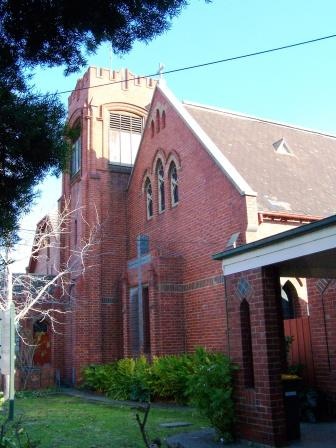
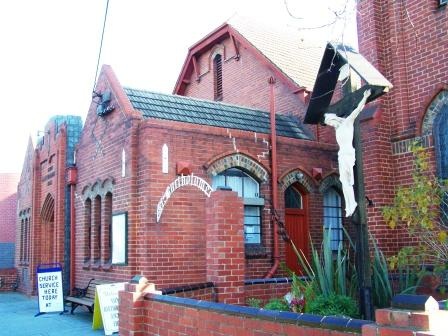
Statement of Significance
-
-
290 & 300 Burnley Street - Physical Description 1
The church is a red brick building with a gabled slate roof and a crenellated corner belltower. The church has pointed arch traceried windows with clinker brick dressings and red brick head moulds and brick sills. The entrance porch is located at the base of the tower and a spiral stair leads to the bell chamber. The belltower has high segmental arched openings framed by red brick mouldings, and contains the eight bells, hung in a configuration for full circle ringing. The tower has red brick staged buttresses. A clinker brick soldier course runs around the building at impost level of the lower arched windows. The intactness of the church interior is good: it has a dark stained timber trussed roof.
The hall is a single-storey red brick building with a (re-tiled) jerkin head roof and pointed arch window and door openings. The entrance, on the east elevation, has simple brick orders, and is framed by a heavy door-case trimmed with contrasting blue bricks or terracotta tiles. The entrance is flanked by two gable-ends, each decorated with blue brick diaper work, and penetrated by three arched windows, the details of which match those in the church. Along the south elevation, the windows are set between brick piers, and below a projecting concrete lintel resting on terracotta brackets. To the rear of the hall is the Guild Room, the entrance to which is similar in composition to that of the main hall. Both the Guild Room and the hall retain original signage above their respective entrances.
The vicarage is a single-storey red brick building.
The low brick front fence to the church is not original.290 & 300 Burnley Street - Integrity
not assessed
290 & 300 Burnley Street - Physical Description 2
The church is a red brick building with a gabled slate roof and a crenellated corner belltower. The church has pointed arch traceried windows with clinker brick dressings and red brick head moulds and brick sills. The entrance porch is located at the base of the tower and a spiral stair leads to the bell chamber. The belltower has high segmental arched openings framed by red brick mouldings, and contains the eight bells, hung in a configuration for full circle ringing. The tower has red brick staged buttresses. A clinker brick soldier course runs around the building at impost level of the lower arched windows. The intactness of the church interior is good: it has a dark stained timber trussed roof.
The hall is a single-storey red brick building with a (re-tiled) jerkin head roof and pointed arch window and door openings. The entrance, on the east elevation, has simple brick orders, and is framed by a heavy door-case trimmed with contrasting blue bricks or terracotta tiles. The entrance is flanked by two gable-ends, each decorated with blue brick diaper work, and penetrated by three arched windows, the details of which match those in the church. Along the south elevation, the windows are set between brick piers, and below a projecting concrete lintel resting on terracotta brackets. To the rear of the hall is the Guild Room, the entrance to which is similar in composition to that of the main hall. Both the Guild Room and the hall retain original signage above their respective entrances.
The vicarage is a single-storey red brick house comprising the c.1870s cottage and the 1926 addition. It appears the 1926 addition comprises the front section of the house, which has a transverse gable roof, now clad in Colorbond, with a projecting gable. The projecting gable has a box-bay window with a separate flat roof and double hung timber sash windows with diamond-pattern leadlight to the upper panes. Beside the gable, and projecting slightly forward of it, is an almost flat-roofed verandah supported on wide brick piers with pointed arch cut-outs, and there is a 'blind' window with a pointed arch in the wall to the left of the verandah. The vicarage is clad in red brick with clinker-brick highlights used as single and double row bands on the balls and as patterning in the tops of the verandah piers and 'blind' window, and there is an original or early copper nameplate with 'St Bartholomews Vicarage' beside the front door, which has a top-light. The Victorian origins of the house are demonstrated by what appears to be the original rendered chimneys with moulded cornices and terracotta pots and the large tripartite window beside the front door.
There is a low brick front fence to the vicarage, which appears to date to the post-war era.
Heritage Study and Grading
Yarra - Richmond Conservation Study
Author: John & Thurley O'Connor, Ros Coleman & Heather Wright
Year: 1985
Grading: CYarra - City of Yarra Heritage Review
Author: Allom Lovell & Associates
Year: 1998
Grading: LocalYarra - City of Yarra Review of Heritage Overlay Areas
Author: Graeme Butler & Associates
Year: 2007
Grading: LocalYarra - Heritage Gap Study: Review of Central Richmond 2014
Author: Context P/L
Year: 2014
Grading:
-
-
-
1984 - Building Identification Form - Richmond Conservation Study
-
1984 - Building Identification Form - Richmond Conservation Study
-
1984 - Building Identification Form - Richmond Conservation Study
-
1984 - Building Identification Form - Richmond Conservation Study
-
1984 - Building Identification Form - Richmond Conservation Study
-
1984 - Building Identification Form - Richmond Conservation Study
-
1998 - Building Citation - City of Yarra Heritage Review, Allom Lovell and Associates
-
1984 - Building Identification Form - Richmond Conservation Study
-
-
-
-
FORMER INVERGOWRIE LODGE
 Victorian Heritage Register H0517
Victorian Heritage Register H0517 -
INVERGOWRIE
 Victorian Heritage Register H0195
Victorian Heritage Register H0195 -
RESIDENCE
 Victorian Heritage Register H0710
Victorian Heritage Register H0710
-
'YARROLA'
 Boroondara City
Boroondara City -
1 Bradford Avenue
 Boroondara City
Boroondara City
-
-







